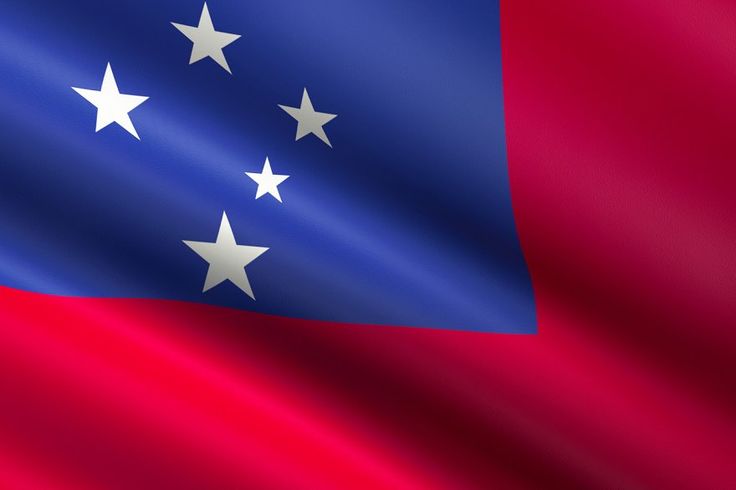The Flag of Samoa is a powerful emblem of the island nation’s history, culture, and independence. With its bold design, it represents Samoa’s journey from colonial rule to a proud, sovereign nation. In this article, we’ll explore the elements of the Flag of Samoa, its historical significance, and the meaning behind its design.
The Design of the Flag of Samoa
The Flag of Samoa features a simple yet striking design. It consists of a red field with a blue canton in the upper left corner. Within the canton, five white stars are arranged in the shape of the Southern Cross constellation, which is a key feature of the night sky visible in the Southern Hemisphere. The red field symbolizes courage, while the blue canton and stars represent the country’s connection to the Pacific and its place in the wider world.
The Flag of Samoa is deeply rooted in the nation’s cultural identity, with the Southern Cross symbolizing the guiding light that has led Samoa through its history. The stars represent the islands of Samoa and the unity of the Samoan people. The red and blue colors are also symbolic of the country’s strength and resilience, qualities that have been integral to Samoa’s identity throughout its history.

Photo: Creative Market
Historical Context of the Flag of Samoa
Samoa’s journey to independence and the adoption of its national flag is a story of resilience and self-determination. Prior to gaining independence, Samoa was under colonial rule, first by Germany and then by New Zealand. The Flag of Samoa was officially adopted on January 1, 1962, when Samoa became the first Pacific island nation to gain independence from colonial rule.
Before independence, Samoa was known as Western Samoa, and the flag used during the colonial period reflected the influence of the European powers that controlled the islands. The new Flag of Samoa was a symbol of the country’s break from its colonial past and its desire to establish its own identity as a sovereign nation.
The Meaning Behind the Flag of Samoa
Each element of the Flag of Samoa carries significant meaning, reflecting the country’s values and history. The red field symbolizes courage, representing the strength and determination of the Samoan people. The blue canton is a nod to the Pacific Ocean, which surrounds Samoa and plays a central role in the lives of its people. The five stars in the canton represent the islands of Samoa, and the Southern Cross constellation serves as a symbol of guidance and hope for the nation.
The Flag of Samoa also reflects the country’s deep connection to its culture and traditions. The stars in the flag are arranged in a way that reflects the Southern Cross, a constellation that has been used by Pacific Islanders for navigation for centuries. This connection to the stars and the ocean highlights Samoa’s maritime heritage and the importance of the sea to the Samoan way of life.
Samoa’s Path to Independence
Samoa’s path to independence was not without challenges. The islands were first colonized by Germany in the late 19th century, and after World War I, they came under New Zealand’s administration. During this time, Samoans faced significant struggles for self-determination and the right to govern themselves. The Flag of Samoa became a symbol of the country’s desire for independence and its determination to break free from colonial rule.
In 1962, Samoa achieved its long-awaited independence, becoming the first country in the Pacific to do so. The adoption of the Flag of Samoa marked a new chapter in the country’s history, as it symbolized the nation’s newfound sovereignty and pride. The flag was a representation of the Samoan people’s resilience and their ability to overcome the challenges they faced during their colonial past.
The Flag of Samoa Today
The Flag of Samoa is a symbol of national pride for the Samoan people. It is flown at government buildings, schools, and public events, and it is a common sight during national celebrations such as Independence Day, which commemorates the country’s independence from New Zealand. The flag is also used by Samoans around the world as a symbol of their heritage and identity.
The Flag of Samoa is also a symbol of the country’s place in the Pacific region and its growing role on the global stage. As a member of the United Nations and other international organizations, Samoa uses its flag to represent its interests and to assert its sovereignty in the international community.
The Flag of Samoa and National Identity
The Flag of Samoa plays an important role in shaping the country’s national identity. It is a symbol of the country’s history, culture, and values, and it is a source of pride for the Samoan people. The flag represents the strength and resilience of Samoa, as well as its deep connection to its cultural heritage.
For many Samoans, the flag is a reminder of the struggles their ancestors faced in their fight for independence and self-determination. It is a symbol of the sacrifices made by previous generations and the achievements of the nation since gaining independence. The Flag of Samoa is a constant reminder of the country’s journey from colonialism to independence and its ongoing efforts to build a strong and prosperous future.
The Flag of Samoa in the International Community
As Samoa continues to grow and develop on the global stage, the Flag of Samoa serves as a representation of the country’s independence and its commitment to its values. The flag is flown proudly at international events and is a symbol of Samoa’s place in the world. Whether at the United Nations or at regional Pacific gatherings, the Flag of Samoa is a visible reminder of the country’s sovereignty and its unique cultural identity.
Conclusion: A Proud Symbol of Samoa’s Identity
The Flag of Samoa is more than just a national symbol—it is a representation of the country’s history, culture, and pride. From its colonial past to its independence and modern-day significance, the flag reflects Samoa’s journey as a nation. The Flag of Samoa is a symbol of resilience, unity, and self-determination, and it will continue to fly proudly as a reminder of the country’s strength and the achievements of its people.
Samoa can be visited as part of our Least Visited Countries Tour.





